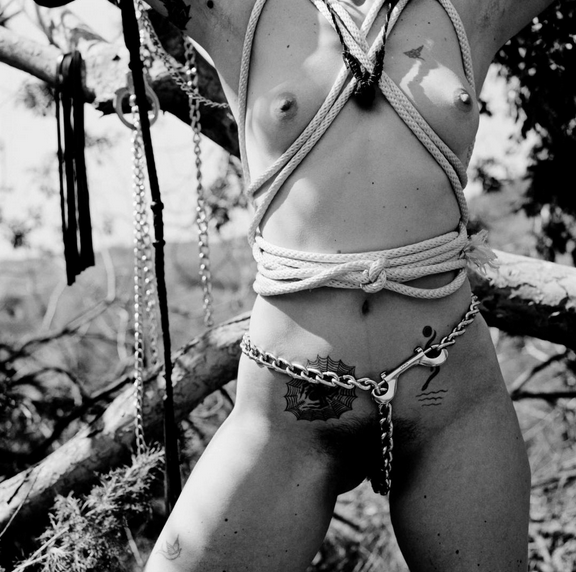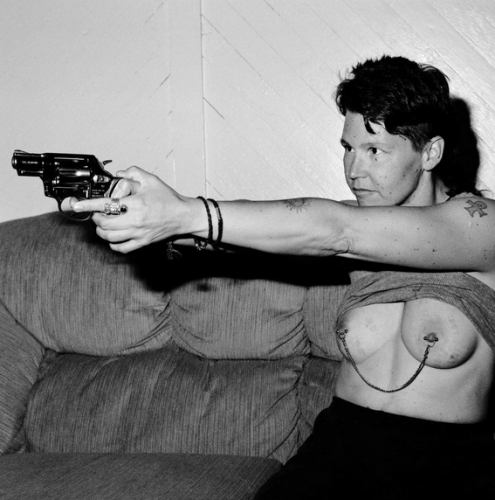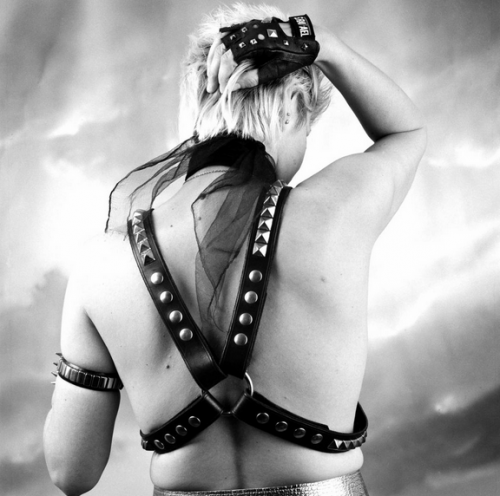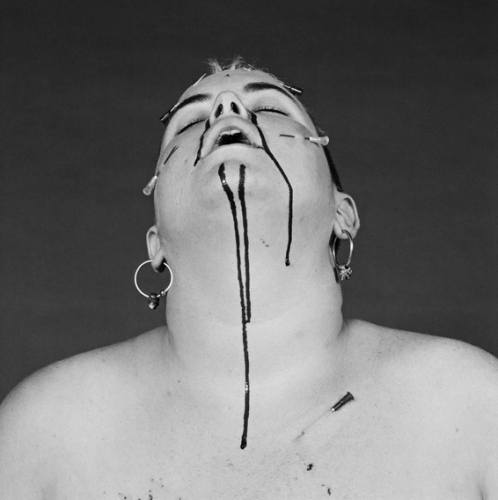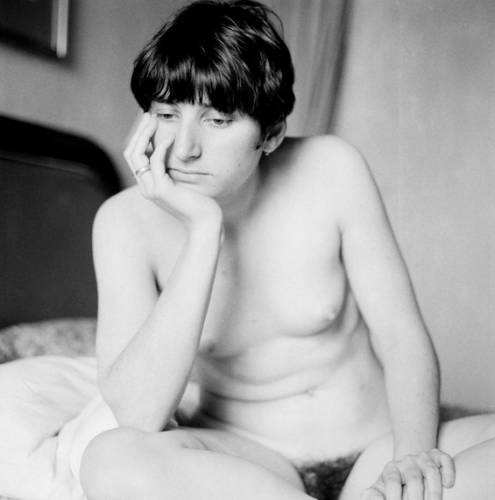Interviewed & photographed by Andrea Blanch.
Do you dictate the poses of your subjects at all? How do you feel posture and eye contact play into your theme of a community spectrum?
Oh, yea I pose all of my subjects. I’m very controlling in the studio. Incredibly controlling. It usually takes 40 to 45 minutes for a sitting because sometimes I change the light a little bit, you know so some things are a little longer. When I did the pierce thing, it takes a little longer to take the needles out, and [other] photos where it takes longer to dress [my subjects] but it’s pretty quick. I work with people pretty quick, I don’t overshoot things, I move them immediately, direct them. Try to see what I have in my head through my camera, get it, and done.
How do you see West Coast photography evolving as the process becomes continually more accessible?
I think it’s a universal conversation. It doesn’t have a binary East Coast or West Coast, I mean I think my colleague James Welling is seen as one of the forefront in abstract photography definitely but he was living in New York all that time before he began teaching on the West Coast. So I have to say that the East Coast is more process oriented ultimately. There was experimenting on the West Coast, but I think on the East Coast you can even go back to surrealism and Man Ray. If you took the history of photography and charted it out, basically the conversations are going on in all places.
Being UCLA faculty, how has that didactic influence shaped your photographs?
Yea, in relation to knowing what the younger generation is thinking. It’s really interesting, It’s a good thing to be doing. Also when your talking about other people’s work all the time and questioning it in relation to critiquing it you have to bring more self-critique to your own work. You have to figure out what your asking of them, and what you have to ask to yourself for a little bit. So I think it creates a very powerful dynamic of being able to look at one’s own practice of also looking through the lens of being a professor.
Where do you think photography is headed now? I know it’s a banal question, but that’s why they brought motion.
I don’t do video as installation. I want to, I just haven’t. So far the photographs have just served me and the way that I work. Well, that’s not true. I did make a video for my show in New Zealand. That was the first time I did video for an installation.
Your work finds profundity with aching, haunting. Does that same emotional connection follow your goals and personal relationships?
No, not really. I’m much more humorous in life. The human condition is about all of those other nuisances, which are definitely internal things within me. This latest body of work comes out of a very internal place of getting control of my body in terms of physicality, during menopause. It’s about bleeding, blood, and saying goodbye to your blood. It’s a love story to a kind of human emotion and people that I want to look at. Dave has blood all over his hands because he’s bleeding for me. He’s my trainer, I’ve been working out with him for two and a half years. He’s been really working hard at getting me to be mobile and mobility wise…
What kind of lighting did you use?
It’s all strobe. I have fernels, spots, and soft boxes.
What young photographers currently captivate you, and why?
I’ve been really enjoying the conversations I’ve been having with Lucas Blalock about photography. He really understands the history of it and has been a student that ive had to really think about his practice. Hes so good at what he does. That’s been really inspiring to work with because hes also exhibiting and doing really well career wise while hes been getting his masters degree and I'm impressed with how hes trying to figure it out. I’m also interested in Liz Deschend and I really love Luisa Lambry’s work as well. Luisa Lambry is represented by Mark Fox Gallery, Lucas Blalock has a gallery in New York that represents him, I don’t know the name of it, but he had a show at PS1 as well. I've been teaching at Chicago Art Institute and I’ve been on the panel at Yale, so I’m constantly looking at student’s work and talking to them about it. I’m also constantly going to other schools to do lectures and also doing studio visits. I’m just impressed that people still want to be artists! I’m impressed that they're continuing to move the dialog forward in relationship to the possibilities for and the potential of this medium. When you asked if I get tired of the different kind of processes, its like no not really because it is a moment within a history that’s being created in the same way that what street photography was doing in a certain moment in relationship to when MoMA was looking at it and the kind of conversations it brought forth from its own materiality and medium and specificity of it. I think all of it is super important because were all trying to digest it and figure it out and then our job as artists is to decide what paths we want to traverse in relationship to our own work and our own language within it.
Do you think grad school is important?
For the right people it is, I think its important to really have that time in terms of having the ability of talking to people one on one about the work and moving your work forward beyond an undergraduate. But you have to decide to, either go into debt if you don’t have parents who pay for it and you have to decide that it’s a big commitment and that even if you get an MFA doesn’t mean that its all gonna work out for you as an exhibiting artist. Its still a very competitive field that seems hard to figure out how to enter sometimes. If you go in it because the work is the most important thing for you and not the idea of the career then those are the right decisions to go to grad school because it’s all about what you’re trying to do with your work. Not because you're trying to get into a school that’s going to vent you to further create these careers for you. It does help going to good schools, but it has to happen from the work first. You have to be invested enough within the work for you to go for it. Grad school is different, you have a studio, a peer system, everyone’s a bit older, you’ve gotten out of undergrad and are not doing that some course work. It’s two years of intensive dialog and conversation and critique about your work that hopefully will, and then at the end you have to have a thesis show and that’s how you end up working if your fortunate enough to be able to continue to make work that people want to show, you're on a two year cycle. Every two years, I have an expectation to have an exhibition up at one of the galleries that represents me.
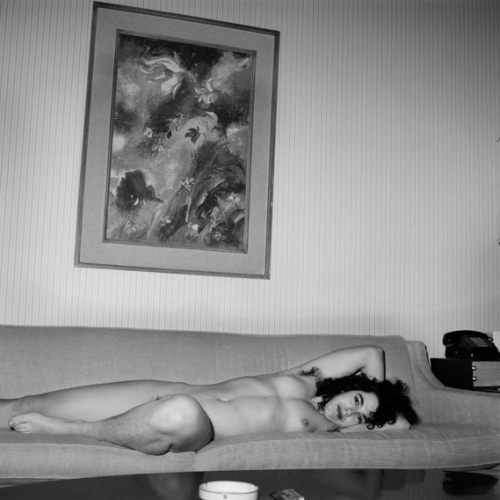
Do people who study with you coming out looking like Catherine Opie? They do in Yale like Gregory Crewdson.
My undergrads, well I teach them how to light so sometimes their lighting looks like mine because I’m teaching them what I know in lighting, but my grads no I would say that Jim and I do not have a singular identity to the program and that were very careful of not having that. We actually really like to see our jobs as professors is to mentor their own ideas within their work not to mold them to be like us. Were not interested in that.
Have you taken a nude picture of yourself?
Pervert is a self portrait, topless at least.
Why did you decide to do that?
That piece was in relationship to the march on Washington regarding GLBT rights in the 90’s. The fact that all of this sudden the leather community was being called by the GLBT community the perverts saying they don’t represent us. I was like I'm going tow ear the language on my body and be Henry the 8th with it! I’m going to be like a Holbein (??) portrait in relationship to this and be the king soldier… not soldier I hate saying soldier, you know owning it, being it, presenting it, bringing it forth, and creating a dialog.
Would you do that now?
No. I did it in 1994, so don’t need to go there again.
What about nudes in general? What do you think the nude informs us of?
With David, his body is so unbelievably beautiful. When I did the back of Diana its just like her swimsuit marks… I like skin I never think of them as nudes, so its so interesting when you bring up the word nudes because I never think of nudes, I just think of bodies and I think of skin and I think of it as a substance that’s part of our being. Nudes to me implies this kind of nuduity or this classical sense or the idea of the nude in relationship to the history of photography and art like Bill Brandt titling them Nudes or this and that. I never think about it that way I think about it as skin.
If I say the word nude, what comes to mind?
Classical Edward Weston photographs and Bill Brandt and this kind of male observation of the female body comes to mind in terms of nudes.
And if I say the word naked?
Naked for me is just wearing no clothing and bearing your body to the world.
How does living out essentially the idyllic American domestic life make you reflect on your own work?
That’s such a funny question. I am very happy with my life. I have a relationship that’s an amazing relationship and we have two amazing kids. One’s not a kid anymore she’s 33. I don’t know that’s a hard question to answer. I don’t ever think that I have everything that I want, but I do know that I'm very fortunate to have a public that has followed my work for over twenty years now and that I have an amazing support system around me and an incredible partnership with an amazing person who’s also a brilliant artist. All of it for me has been also like I have worked incredibly hard. I have really worked hard at this. It’s a lot of work what I do. I travel a lot, I think a lot, I try to influence, I try to be a really caring and responsible professor, I don’t take my status for granted in this system. I think that it could all collapse on me at any moment. I try to keep pushing the work forth not only for myself but also for the audience that has followed me. I feel a sense of responsibility to that. I think people think that the idealist American dream is at some point you can just rely on your position of what you’ve created for yourself. I don’t think that I, as a woman artist can rely on that to be honest. I don’t think that women artists can rely on it in the same way.
Do you think theres that attitude difference between a male and female artist?
I think theres no difference between us except for that men still predominantly still make most of the money and predominantly take up most of the museum square footage, but in terms of the quality of work and the dynamic of work no there’s no difference. Haha!
How defined is the female form by its context, personality, and controversy?
That’s complicated. Controversy in relationship to feminism and women’s rights, yes there is a controversy that often sometimes theres an expectation on a societal part that we shouldn’t have the rights to our body and the rights to choose and that’s a controversy. Why at this point are men in powerful positions making decisions in relationshop to our rights and it’s a controversy in terms of the LGBT community and not being able to have full rights. All of that for me is the politics of controversy which is looped to the body and the notion of the body politic and how we begin to view it in society unfortunately through radical right wing agendas in terms of Christianity. Its not just Christianity, its women world wide. When you go to countries in which women have no rights and they have to be covered, and these horrible things that are going on in India in relationship to women being raped. That’s the controversy around the body in terms of it always being anobject of ones taking. That is really horrible, depressing, and frustrating. It feels like how do we even get to the place of changing this. The fact that a woman gets raped still in this country every three minutes in the United States of America. That’s to me the controversy in relationship to the female body. The context and personality are harder for me to unpack. It gets very abstract! I’m working on age, vulnerability, and tenderness…
How’s it going? Working on the age?
That it’s still as beautiful as a 20 year old to me. That beauty is timeless in a certain way. Why do we assume that there isn’t beauty in women who their bodies are growing older. I'm so tired, especially in this town, you see men with these very young women and wives and partners get left because their aging and so forth. Its sad to me.
Well, then you’re handling it well.
Yea.
Okay, there’s more. How did you modify your conceptual goals or did you, when you were photographing for Rodarte?
My modification of my conceptual goals for Rodarte is that half the people would be the supermodels, which I don’t work with, and then half would be my friends. That was the only way for me to feel like I could have some kind of voice for the project because I really do use my friends to model. I love the picture of Oliver and my son when hes wearing the dress and I love the picture of my student where you can total see his penis through the netted stockings. That for me allowed me to move within it that allowed it to be personal as well as doing fashion images. I mainly tried to do it, not just about clothing, but tried to keep it very formal in relationship to ideas of portraiture. They’re portraits.
Do you think women artists have a responsibility with their art to make art that doesn’t procure more of the male gaze?
Theres a big difference between the way a woman looks out of my photographs than Greg’s photographs. I love Greg’s photographs, but they’re the vacant woman staring off that embodies nothing. My women embody space, they look back at you, they look off at you, I've always treated women in relationship to holding a sort of power within the frame and a lot of male photographers photograph the woman only as object. My portraits are never about objects they’re always still about a person. I never think of the body as an object. Do you think my photographs look as such?
Oh no! As you’ve evolved through the S&M culture through surfing and football. The concept of communal violent play still remains in your art. Do you see that as a vital component of our society?
You're asking very hard questions! The S&M community was a very important part of my life through the 90s and I chose to photograph it because I didn’t like the way it was being represented. Often, when I make things its in relationship to creating a representation of that, that I feel needs to be in the world. I'm just fortunate enough that it actuall got to go out in the world. The other aspects of community are in relationship to the ideas of quality. Why would I give myself permission to photograph my own community, but not actually go to the site of a highschool football field? There’s no contradiction within that, I have every right to bear witness to any group of people as long as its done with humanity in mind and also humility. I've always felt that I have never been tied down to a singular identity, so why should my work? Were much more complex as people in relation to our thoughts and politics and how we go about the world and so why should the work not also have that breath? Its like the minutiae that goes on in my brain.
You answer these difficult questions very well! I’ve heard you speak on how much you enjoyed driving from a very early age almost mirroring your photographic career. Do you find an innate interest in mechanized action, if so, how does that serve to shape your work?
I like mechanics, I like cameras, I don’t like the computer so much, that’s still a bit of a mystery to me. But I certainly understand how the digital cameras work. I've always like machinery. My dad had a factory and I grew up when he made bass wood boxes and plaques and so I grew up at the Opie Kraff factory in Sandusky, Ohio having to watch the workers make things. I think that I like cars because it represented freedom to me when I was 16 in the same way that when I got a bike when I was kid. I could traverse through Ohio in a very different speed and different relationship to it. The possibility of discovery in relationship to going outside your own home is very exciting and its also supported by this kind of mechanization that you're talking about. Its always equated to me with this kind of sense of freedom and permission to explore.
How have your photographic processes evolved over the course of your career? Where do you see them going in the future?
I switched over to digital seven years ago. I still want to pull out the 7 by 17 banquet camera, but haven’t just because its such a pain in the ass. I haven’t finished American cities. I have two American cities I want to photograph: Pittsburgh and Houston and I haven’t finished those yet. I have seven cities done now.
How long does it take you to do that?
Oh a year.
And you keep going back and forth?
Yes, and its harder ever since I had Oliver I just don’t have that kind of freedom. I try not to be away from the family. Our rule is 10 days. The longest I’ve gone is 14 because of the ship going from Korea to the port of Long Beach it was a voyage.
What’s the goal of American Cities?
American Cities deals with the specificity of identity that we hold within the architecture of different American cities. We look at these spaces on an iconic level, or one that is non-iconic, like one wouldn’t think of mini malls as iconic to LA, but by photographing them all of this sudden I brought forth this dialogue about the diversity of the city through the façade of the mini mall. Chicago was done on how they like the architecture at night. Its in relationship to that history of photography from Atget to Abbott and on, that I just found really important and that I wanted to participate in with this larger body of work called American Cities.
How does the nude play a role in defining the self and the art historical references you utilize?
In terms of art historical references, it’s about seduction. Using art history as a place to land people in the photographs in which they might not have considered or that they actually bring opinion to, especially in the earlier portraits. They might think, ‘god the gay and lesbian community why are they on the wall,’ or homophobia might arise. If I use the refinement of history and aesthetics to bring the subjects forth to have the viewer spend a longer time with it, then why not use those tropes? I also like those tropes. I like to light really well and I like to make the images pop in a certain way. I like trying to do something different that I feel that the photographic portrait hadn’t done before. When I started that and used Halbein (?) back in the 90s, that wasn’t being done in terms of portraiture. Portraits were staged, there was definitely staged photography going on. But the photograph itself, the way that it bared light, wasn’t the way that you saw it in my portraits.
Do you consider yourself a portrait photographer?
I consider myself an artist, but I like making portraits! Singular identities remember, I avoid them! Haha!
When you got out of University, you started supporting yourself as an artist right away?
Oh god no. When I graduated from San Francisco Art Institute with my Bachelor’s degree I stocked produce at Rainbow Grocery for 40 hours a week. When I graduated from CalArts to get myself through CalArts I loaded trucks during a swing ship for UPS. After I graduated, before I even got my degree, I walked around to all the camera shops and put in a resume and I became rental manager at a camera store that doesn’t exist anymore called Pan Pacific Camera.
Were you doing your work during this time?
Always, always. You never don’t make your work. The key to it is always to make your work even if you have the crappy 40 hour week job, that the work comes first always.
What advice would you give an emerging photographer?
Make it about the work, your ideas, and look at what’s around you, but don’t feel that you have to make work that reflects a contemporary discourse. Allow a contemporary discourse to seep into the work because of your own interest versus thinking that you have to do this because that’s what’s being done right now. It has to really come out of a place that you have a lot of desire in. You must have a relationship to your explorations that you can be married to for awhile. It is a marriage, in a certain sense of a word. It’s also something that I can’t have, legally, anyway. I do have a marriage, it’s just not legal. It is that dedication and perseverance.
What if somebody now wants to shoot analog?
All of my students shoot analog. I don’t have one graduate student who does digital. All of them shoot large format. They're all doing that still.
How do they bring that into modern discourse?
The work can still reflect on a history. Don’t go with the populists, go with what’s important to you.
How does hetero-normativity, and the queer resistance to it, sculpt your concepts of community?
I think that in some ways, the queer resistance is always bringing focus to the queer community. My deciding to use it as a subject is about compassion and creating a history. When I started making the earlier portraits I literally thought okay I'm fucked, I'm not going to be able to ever get a teaching job, never going to be able to show in any galleries, the work is going to be too radical. The opposite happened. Don’t question, make what you feel is innately really important to you. Hetero-normativity is lessening now. My 11-year old son can sit and watch Glee and watch The New Normal and Modern Family and have representations of gay and lesbian families on TV which is literally like a miracle to me. Opinion is changing. Hetero-normativity is not the new normal! We are becoming more open as a society in relationship to it. For the most part, everybody has somebody that they know who is a member of the LGBT community. It would be very strange to meet someone who has never met a gay person at this point, which you couldn’t say 30 years ago because people weren’t out.
Who is another high profile person that has also contributed to that?
Robert Mapplethorpe, huge. So important. Those culture wars, for it to go all the way to court in Cincinnati and for the images not to be removed from the museum, that was huge. That was really huge. There were other people whose work was only known within the community. Robert was really important, Keith Haring was as well. Act Up and Queer Nation did an enormous amount in relationship to the politics of visibility and grand theory. That created an ability for me, as somebody who was a part of those movements, to decide to go ahead and move my work away from only doing work like nude topographics to doing work on my own community. Even though I didn’t think that I would be able to move forward career wise within it, it was too important for me not to do that. It was too important to be a part of this discourse in that moment of time.
What are you going to do next?
I'm going to make more portraits; I'm not done with them. There are people that I want to photograph that I'm trying to get access to. I really have always wanted to make a portrait of Joan Didion, she’s at the top of my list. It’s very hard to get access to her. I’m going to keep making things and we’ll see what happens.
Is this show coming to New York?
Yes, next spring at Mitchell-Innes and Nash who I show with.


